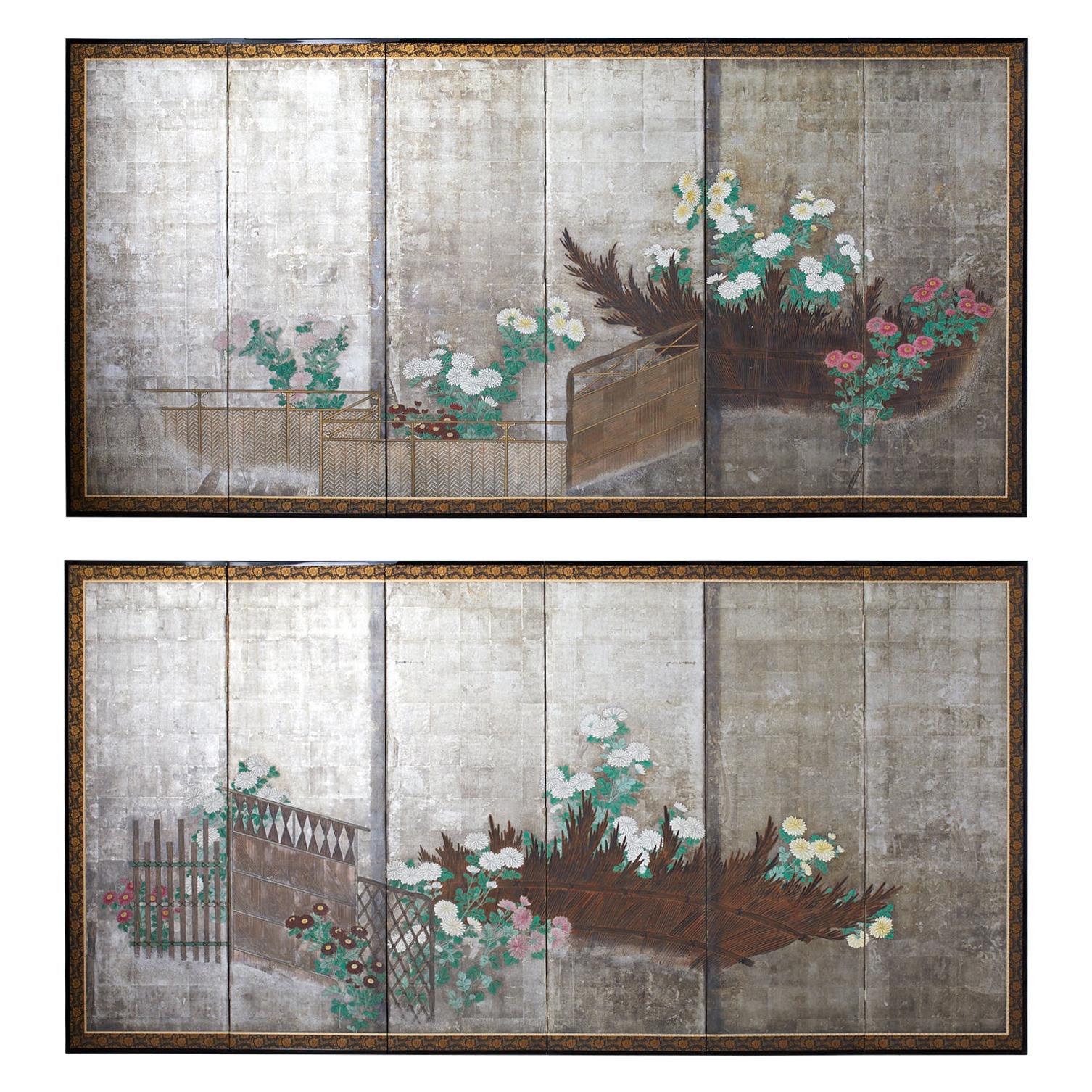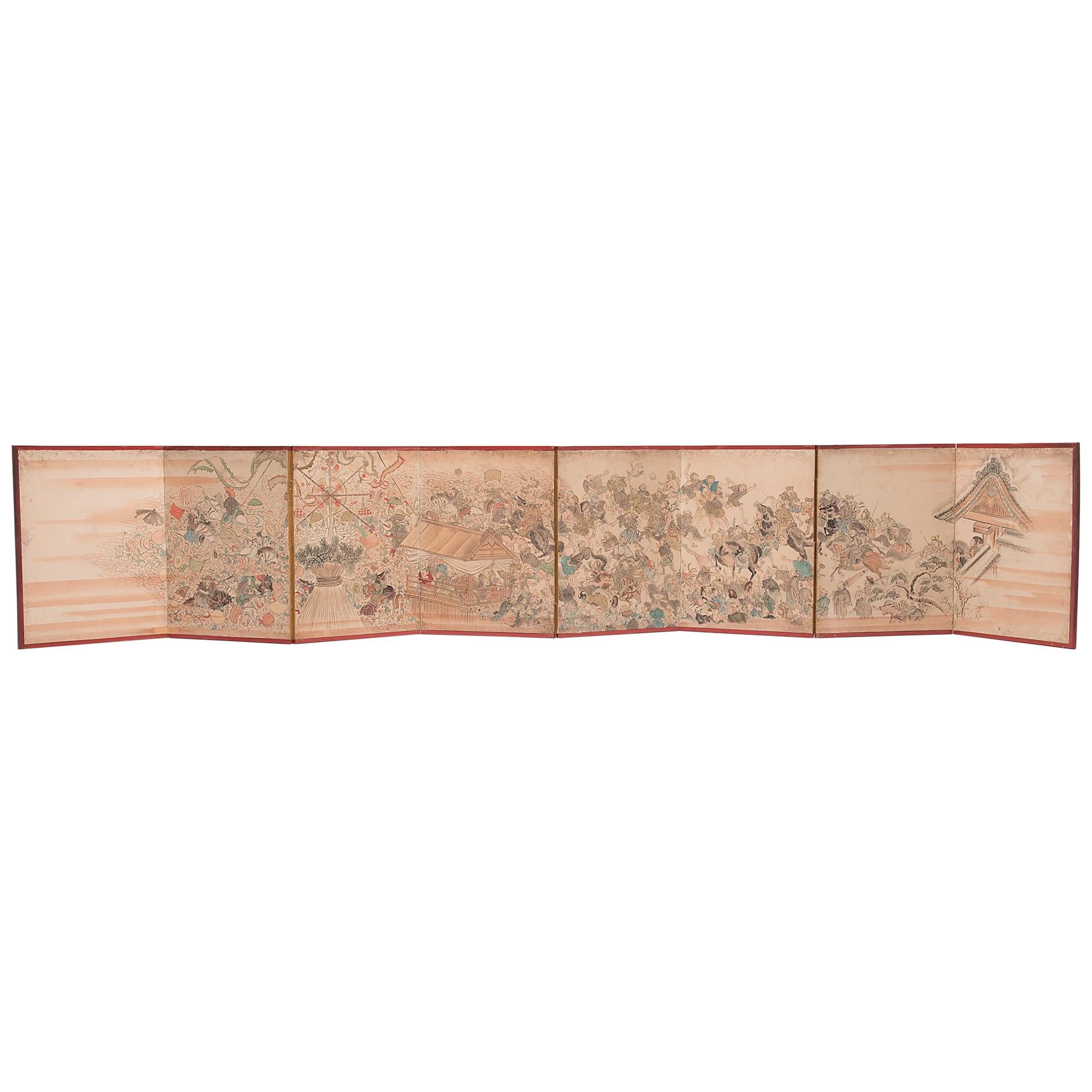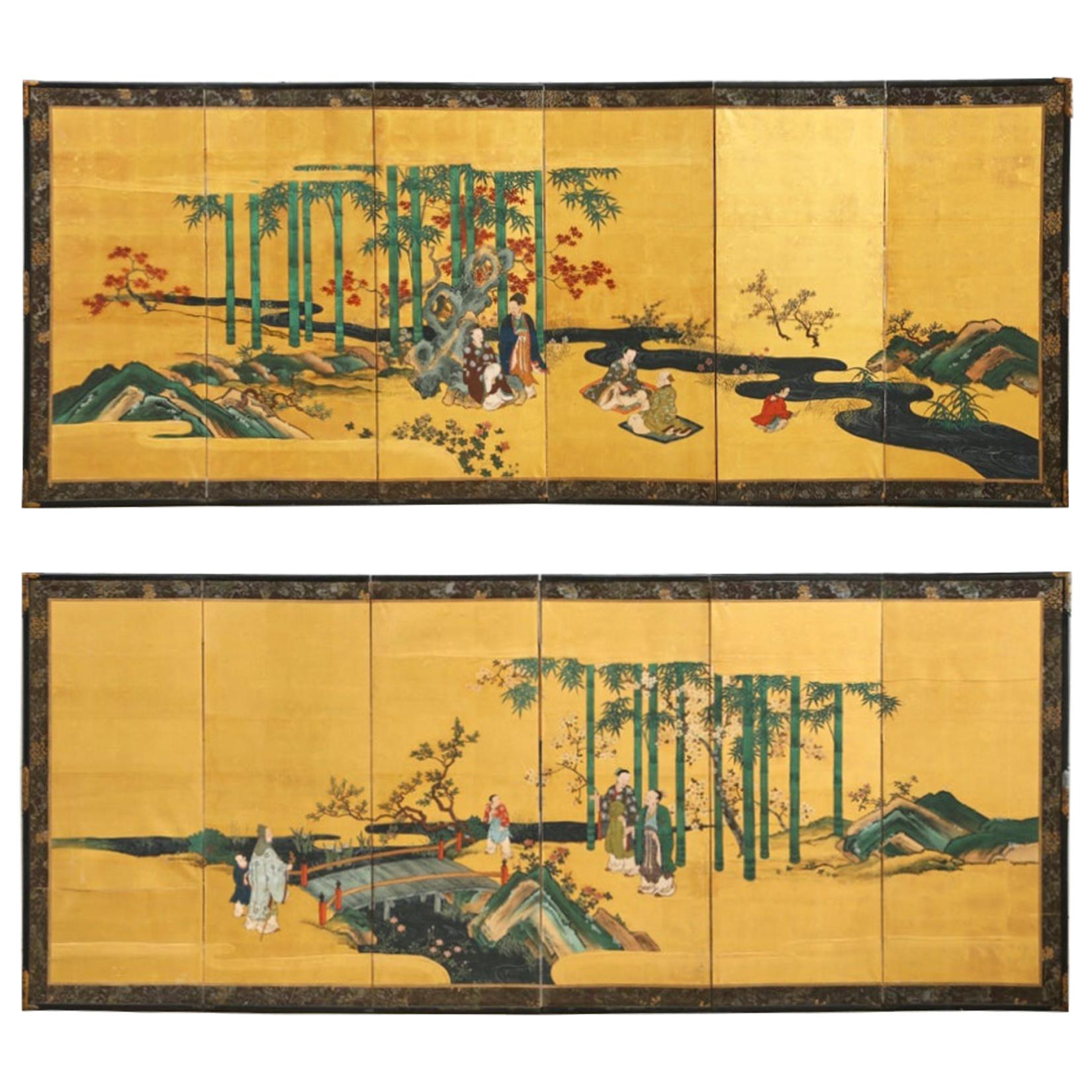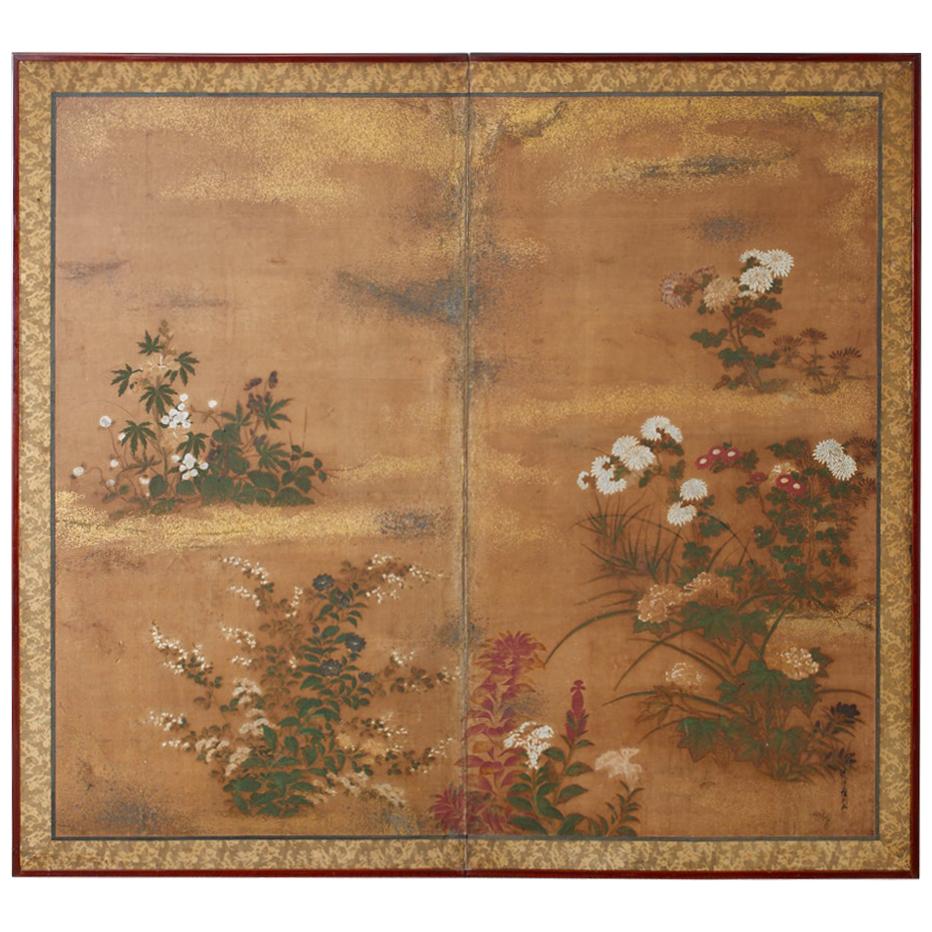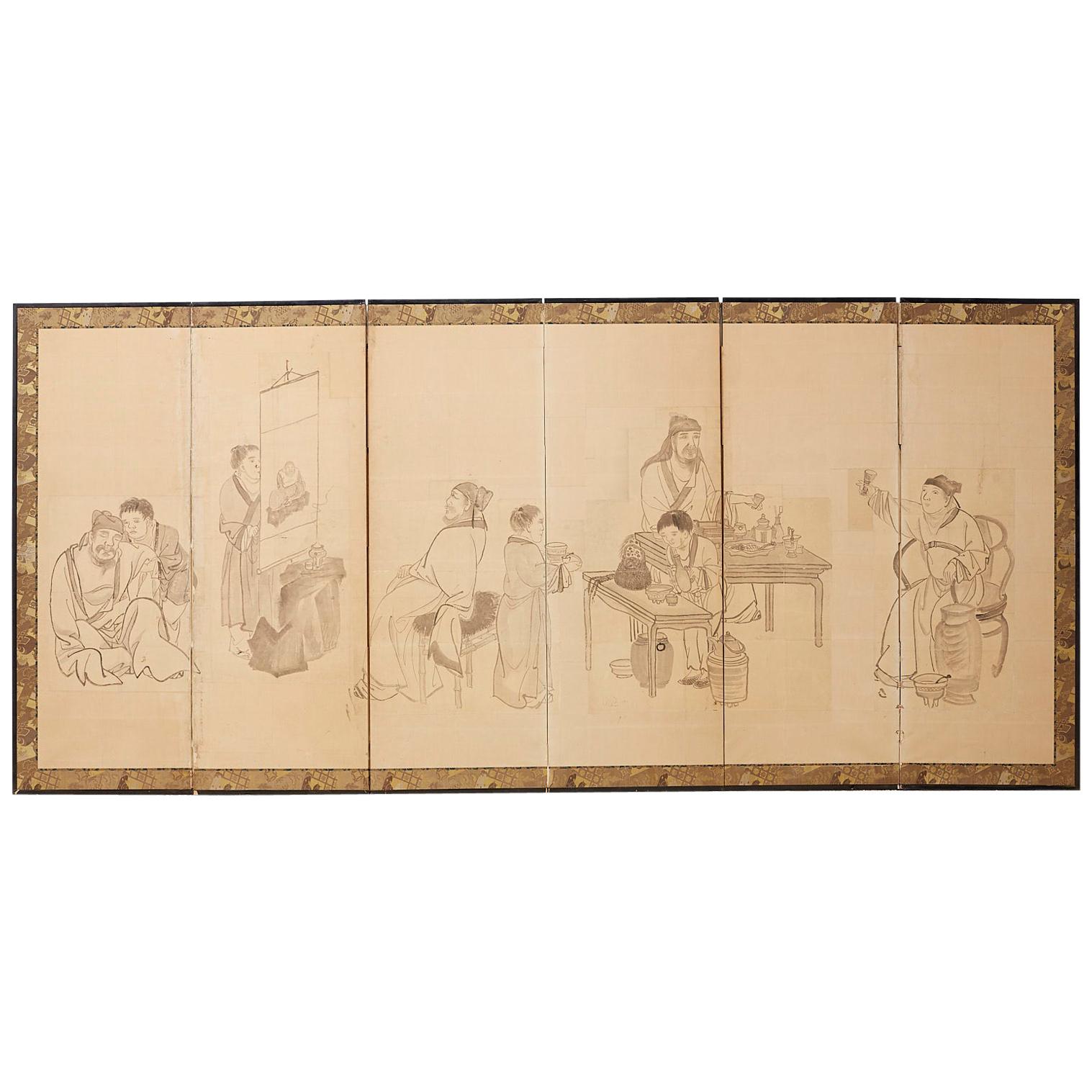Items Similar to Pair of Japanese Edo Rimpa School Screens after Tawaraya Sotatsu
Want more images or videos?
Request additional images or videos from the seller
1 of 21
Pair of Japanese Edo Rimpa School Screens after Tawaraya Sotatsu
About the Item
Impressive pair of 17th century Japanese Edo period Rinpa school screens made in the manner and style of Autumn Grasses by Tawaraya Sotatsu (1570-1640). Beautifully decorated with wild flowers and grasses. Ink on paper with gold flecks set in lacquered frames. Each having an artist three character seal. From an estate in Beverly Hills, CA.
- Dimensions:Height: 60.5 in (153.67 cm)Width: 131 in (332.74 cm)Depth: 0.75 in (1.91 cm)
- Sold As:Set of 2
- Style:Edo (Of the Period)
- Materials and Techniques:
- Place of Origin:
- Period:
- Date of Manufacture:Late 17th-Early 18th Century
- Condition:Wear consistent with age and use. Beautifully crafted with age appropriate wear including losses, fading, stains, and wear as seen in photos.
- Seller Location:Rio Vista, CA
- Reference Number:1stDibs: LU1555219549632

About the Seller
5.0
Erin Lane Estate is based in the San Francisco Bay Area, and its team of furniture restorers, art curators, professional appraisers and Asia specialists sources prime vintage and antique furniture from the finest estates in Northern and Southern California. Erin Lane Estate specializes in Hollywood Regency, McGuire, Chinese and Japanese pieces.
Diamond Seller
These expertly vetted sellers are 1stDibs' most experienced sellers and are rated highest by our customers.
Established in 2000
1stDibs seller since 2015
2,645 sales on 1stDibs
Typical response time: 1 hour
- ShippingRetrieving quote...Ships From: Rio Vista, CA
- Return PolicyA return for this item may be initiated within 1 day of delivery.
More From This SellerView All
- Pair of Japanese Edo Screens Chrysanthemums Along FenceLocated in Rio Vista, CARemarkable pair of early 19th century Japanese late Edo period screens depicting summer chrysanthemums growing along a brushwood fence. Ink and...Category
Antique 19th Century Japanese Edo Paintings and Screens
MaterialsSilver Leaf
- 19th Century Japanese Edo Six Panel Kano School Landscape ScreenLocated in Rio Vista, CALate Edo period 19th century Japanese six-panel landscape screen featuring a cypress tree over a flowering hibiscus with a pair of hototogisu birds. Kano school painted with ink and ...Category
Antique 19th Century Japanese Edo Paintings and Screens
MaterialsSilk, Wood, Paper
- Pair of Japanese Edo Six Panel Screens the Seven SagesLocated in Rio Vista, CAFantastic pair of 19th century Japanese late Edo/early Meiji period six-panel screens titled The seven sages of the bamboo grove. The Kano school screens...Category
Antique 19th Century Japanese Edo Paintings and Screens
MaterialsBrass, Gold Leaf
- Japanese Edo Two-Panel Screen Flowers of AutumnLocated in Rio Vista, CAImpressive early 19th century Japanese Edo period two-panel screen featuring flowering plants and grasses of autumn. Painted in the Tosa School style Bunka Bunsei period or Ogosho pe...Category
Antique 19th Century Japanese Edo Paintings and Screens
MaterialsSilk, Wood, Paper
- Japanese Edo Period Six Panel Screen of Chinese ScholarsLocated in Rio Vista, CAFascinating 19th century Japanese late Edo period six pane funpon screen. Large scale depicting Chinese scholars and officials engaged in leis...Category
Antique 19th Century Japanese Edo Paintings and Screens
MaterialsWood, Paper, Silk
- Japanese Four-Panel Rimpa Screen Floral Autumn LandscapeLocated in Rio Vista, CAMagnificent Japanese four-panel 19th century Meiji screen. Made in the Rimpa School style depicting a serene floral autumn landscape. Beautifully painted sumi ink and color pigments ...Category
Antique 19th Century Japanese Meiji Paintings and Screens
MaterialsBrass, Gold Leaf, Silver Leaf
You May Also Like
- Japanese Edo Festival Screen, c. 1750Located in Chicago, ILThis 18th century folding screen is a stunning example of Japanese artistry. Beautifully painted with delicate brushwork, the evocative screen depicts a lively festival during the Ed...Category
Antique Mid-18th Century Japanese Edo Paintings and Screens
MaterialsPaper
- Pair of Japanese Edo Period Six-Panel Screen, "100 Boys at Play"Located in Austin, TXAn absolutely charming pair of Japanese Tosa School six-panel folding screens painted with the "One Hundred Boys at Play" motif, featuring a multitude...Category
Antique Early 19th Century Japanese Edo Paintings and Screens
MaterialsGold Leaf
- Japanese Screen Pair, Tigers by Kishi Renzan, Late Edo PeriodLocated in Kyoto, JPKishi Renzan (1804-1859) Tigers Pair of six-panel Japanese screens. Ink and gold-leaf on paper. In this monochromatic pair of six-fold Japanese screens painted on gold-leaf, Kishi Renzan has created a breathtaking composition of a family of tigers. The screens are filled with a sense of drama which is conveyed by both the subject matter and the wet, expressive brushwork. The running mountain stream and the towering waterfall allude to refreshment during the summer months and we feel the tiger families familiarity and security within their environment. Renzan’s master, Kishi Ganku...Category
Antique Mid-19th Century Asian Edo Paintings and Screens
MaterialsGold Leaf
- Japanese Six-Panel Screen, Rimpa School Chrysanthemums on GoldLocated in Hudson, NYLate Edo period (1614-1868) painting with an abundant use of gold with beautifully draped chrysanthemums and gold flake clouds. Mineral pigments, go fun, and gold leaf on mulberry pa...Category
Antique 19th Century Japanese Edo Paintings and Screens
MaterialsGold Leaf
- Japanese Screen Pair, circa 1730, Peacocks and Phoenix, Kano SchoolLocated in Kyoto, JPPhoenix and Peacocks. A pair of six-panel Japanese folding screens by Tsunetake Yotei (n.d.) First half of the 18th century. The signature reads 67 year old Tsunetake. The seals read: -Tsunetake no in, -Yotei, -Seishin Dimensions: Each screen – H. 69” x W. 149” (176 cm x 378 cm) A pair of Kano Grand Picture (Waga) screens depicting phoenix and peacocks rich with symbolic meaning. Dating to the first half of the 18th century, from the Kobikicho Kano school in Edo, this pair of folding...Category
Antique Early 18th Century Asian Edo Paintings and Screens
MaterialsGold Leaf
- Circa 1700 Japanese Screen Pair, Cranes & Pines, Kyoto Kano SchoolLocated in Kyoto, JPPines and Cranes Anonymous. Kyoto Kano School. Late 17th/early 18th centuries, circa 1700. Pair of six-panel Japanese folding screens. Ink, gofun, pigment and gold leaf on paper. This bold composition presents two pine trees extending to the left and right across a gold leaf background. One tree is silhouetted against a green ground, golden clouds obscuring its true size, the other stretches across a stylized waterway. The pines are paired with Manchurian cranes with red crests and snow white plumage. Both have been highly auspicious motifs in East Asia since Chinese antiquity. Here the artist utilized fluid and instinctive ink brushstrokes to define the trunk, branches and tail feathers, in strong contrast to the precision and sharp angularity of the crane’s legs and beaks. The adoption of this vast metallic painting support required an unerring sense of design and composition, so that the negative space surrounding motifs could imply context for the otherwise floating pictorial elements. The brushwork detailing the trunks of the pines, the exaggerated dimensions of the pine trees and the strength and dynamism of the composition are all reminiscent of Kano Eitoku...Category
Antique Late 17th Century Japanese Edo Paintings and Screens
MaterialsGold Leaf
Recently Viewed
View AllMore Ways To Browse
Three Screen
Edo Japan
Decorated Screen
Edo Wood
Gold Leaf Art Pair
Japanese Screen Ink
Japan Ink Wood
Japanese Painting Edo
Wild Pair
Japanese Edo Gold
Pair Of Asian Art Paintings
Pair Of Asian Paintings
Gold Screen Japan Leaf
Gold Frame Pair Of Art
Painting With Gold Pair
Japanese Lacquered Painting
Edo Screen
Pair Of Japanese Paintings
